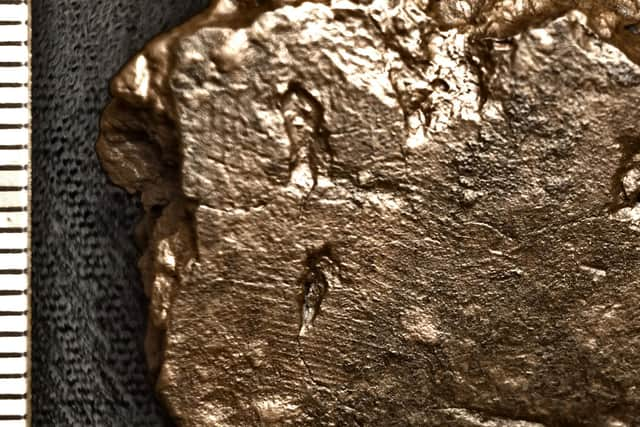5,000-year-old Orkney fingerprint left behind by teenage boy
The print was found on a fragment left at Ness of Brodgar, once a huge complex of monumental buildings in the heart of Neolithic Orkney.
The discovery further tells of everyday life at the site, where feasting, trading and the celebrations of important political and celestial events are thought to have taken place.
Advertisement
Hide AdAdvertisement
Hide AdExperts believe the fingerprint was left on the vessel by the potter, now thought to be have been aged 13 at the time.


Archaeologist Nick Card, of the University of the Highlands and Islands Archaeology Institute and director of the excavations, said: “This is yet another exciting discovery at the Ness, and although it is early days we could be seeing the emergence of a pattern developing for the production of pottery in the Neolithic, which would have implications for the division of labour and tasks.”
The fingerprint is one of eight now found among the thousands of pottery shards at the site, which sits close to the Ring of Brodgar.
Five prints were clear enough to undergo detailed analysis, with the markings identified as belonging both to adult males, aged around 19, and adolescents.
The latest detailed results come from tests on two of the prints, which may have been left by the same person, it is now believed.
Professor Kent Fowler, the director of the University of Manitoba’s Ceramic Technology Laboratory in Winnipeg, Canada, led the analysis.
Although it is not possible to say for certain the same boy left the two prints, Prof Fowler said it was plausible.
He said: “Statistically, the age values of the two are very close – we are talking months not years – and from the variation in the forensic literature you could expect as much from measurements of different fingers of the same person.
Advertisement
Hide AdAdvertisement
Hide Ad“In this case, it is quite likely the prints belong to the same individual given they are so close together and on the same surface of the sherd.”
Although the number of Ness of Brodgar samples is still small, the analysis follows a pattern encountered by Prof Fowler in the Middle East.
He said: “The presence of younger and older prints on all the Orkney sherds so far is interesting and might relate to teaching and learning the craft.
"On Bronze Age pottery from the Levant we found multiple prints of different age and sex and some of the same sex with different ages. I argued this was a 'hands-on' approach to teaching, which is something we can still see ethnographically.”
The fingerprints were discovered by ceramics specialists Roy Towers and Jan Blatchford during post-excavation work on the huge assemblage of prehistoric ceramics recovered from the Ness of Brodgar in what amounts to the largest collection of late Neolithic Grooved Ware pottery in the UK.
Around 3,100BC, Ness of Brodgar was dominated by huge free-standing buildings enclosed by a massive stone wall. Evidence of tiled roofs, coloured walls and more than 800 examples of decorated stone have been found in part of the site.
A message from the Editor:Thank you for reading this article. We're more reliant on your support than ever as the shift in consumer habits brought about by Coronavirus impacts our advertisers.
If you haven't already, please consider supporting our trusted, fact-checked journalism by taking out a digital subscription.
Comments
Want to join the conversation? Please or to comment on this article.
